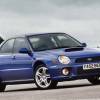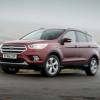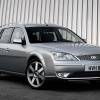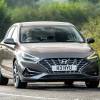
RAC sale – up to 33% off*
• Roadside cover from £5.29 a month†
• We get to most breakdowns in 60 mins or less
• Our patrols fix 4/5 breakdowns on the spot

By Jonathan Crouch
Introduction
The Ford Focus evolved in third generation guise, then further smartened up its act in the revised MK3 form launched in 2014 - the car we evaluate here as a used buy. The idea was to offer slicker looks, higher interior quality and extra technology. Plus with this re-design, the Focus also delivered greater efficiency beneath the bonnet thanks to the addition of a hi-tech range of 1.5-litre petrol and diesel engines. The best part though, is that this car still remains as rewarding to drive as it's always been. The Focus might have grown up a little in this form, but it certainly hasn't lost its spark.
Models
5dr Hatch / Estate (Petrol - 1.6, 1.5, 1.0 EcoBoost, 1.5 EcoBoost, 2.0 EcoBoot, 2.3 EcoBoost / 1.5 & 1.6 TDCi diesel)
History
The problem with success is that it creates an expectation. Whether it's an author looking to repeat the storming sales of a bestselling debut novel or a rock group recording that tricky second album, prolonging success is just as hard as winning it in the first place. Just ask Ford. This improved third generation Focus model, launched in 2015, served as a case study in clinging onto hard-won gains.
To understand its significance, we'll need to press the rewind button for a moment and shuttle back to 1997. Ford's family hatch contender during this period was the fifth generation Escort, a car so all-encompassingly woeful that the brand was almost embarrassed to sell it. When the time came for a replacement, we all expected something better. What we got in the Focus model first launched in 1998 was something much, much more than that, a car that, at a stroke, offered arguably the biggest step forward in family car design the market has ever seen. Here at last was technology directed firmly at the man in the street who, in this apparently humble family hatchback, could experience a car more entertaining and rewarding to drive than almost anything this side of a sizeable lottery win.
It was asking a lot for the MK2 model we saw in 2005 to repeat such a seismic step forward but that second generation Focus was still quite good enough to remain acclaimed as the driver's choice against rival Astras and Golfs that made up for their dynamic failings with a better ride and a more luxurious big car feel. These were attributes the Focus needed too and when it came to developing the MK3 version, first launched early in 2011, Ford tried to provide them without compromising the car's class-leading handling. Here was a design with plenty to live up to, the brand's first truly global model, offered for sale in over 120 countries and aiming to offer family hatchback buyers the last word in comfort, convenience, eco-friendliness and hi-tech compatibility with the modern world.
Lofty ideals that looked credibly realised back in 2011. By 2014 though, the market landscape in the closely-fought family hatchback sector looked somewhat different, the intervening years having seen the launch of impressive new competitors like new generation versions of Peugeot's 308, SEAT's Leon and, most significantly, the Volkswagen Golf. In comparison, the Focus was starting to age a little. Hence the need for the far-reaching package of late-2014 updates that brought us the much improved third generation version of this Ford that we're going to look at here. It was cheaper to run, safer to drive and smarter both to look at and to sit in. It did, in short, promise the kind of significant step forward that was absolutely necessary in retaining Ford's UKs sales leadership in this segment. This car sold until the early Summer of 2018, when it was replaced by an all-new fourth generation model.
What You Get
It's only when you put this improved MK3 Focus next to the original third generation version that you realise just how much more expensive this model looks. Ford's objective was to take this car closer to its arch-rival Volkswagen's Golf in terms of visual sophistication and make switching into a Focus a little easier for those afflicted with any degree of badge snobbery. The most obvious visual change was the addition of an Aston Martin-style trapezoidal front grille, there to give the front end a more distinctive look also emphasised by subtle chrome detailing and slimmer, smarter front headlights and re-styled foglamps.
It was all part of a design approach that aimed to build upon the lower, wider stance delivered by the more dynamically-sculpted bonnet. Moving round to the sides, loyal Focus folk will also take in the sleeker flanks and redesigned alloy wheels - but then such detail changes are of course relatively easy to make. What Ford's designers really wanted to do with this updated model was to correct its predecessor's biggest issue, a general lack of boot space. Since this car had to retain the same dimensions and basic silhouette of its predecessor, they couldn't do that. Instead, the brand had to content itself with a mere styling nip and tuck at the rear that gave us a revised tailgate arrangement and thinner tail lamps.
As a result, Ford dealerships had to continue to direct potential Focus buyers prioritising bootspace to the estate version, the only other bodystyle alternative the range offered to the conventional five-door hatch. Lift the wide-opening tailgate on the hatch model and up to the cargo shelf, there's 316-litres on offer - and you only get that if you choose a car whose original owner (rather unwisely) chose to do without the optional full-sized spare wheel. With that fitted, the capacity falls to just 277-litres, which is getting into Fiesta-style supermini territory. In the rare all-electric model, that figure falls to just 237-litres. Overall with a mainstream Focus model, the bottom line is that a Golf would give you 20% more room and something comparable like a Peugeot 308 would give you nearly twice as much space.
Will that be an issue for potential Focus customers? Well, it didn't seem to be with the original version of this car. Plus of course you can push the 60/40 split folding rear bench forward, though you do have to flip the seat bases up first, which is a bit fiddly. Once that process is completed, you get a completely flat load area and as much as 1,262-litres can be freed up, provided that spare wheel isn't fitted, or 1,176-litres if it has been. Should more room than that be required, there is, as we've said, always the sleek estate version to consider. Though this rides on the same wheelbase, its extra 200mm of rear overhang allows cargo capacity without a full-sized spare to rise to a very decent 476-litres.
Rear seat space is closer to the class standard. Wide-opening doors help to access it and some owners fitted them with neat edge protectors that pop out to prevent carpark dings. Inside, fears that the curved rear roofline will severely compromise headroom turn out to be groundless, though the wedgy side profile does hem you in with a slightly higher windowline. You sit high-ishly positioned for a good view of the road ahead and both head and legroom are adequate, even for a couple of six-footers. As usual with cars in this class, three adults will be rather squashed here, but a trip of kids should find the space provided quite sufficient.
And up-front? Well, with the original first generation version of this car, Ford made great play about having created a design that could be comfortably driven by anyone between four foot nine and six foot nine and ever since, the Focus has remained a great choice for any size or shape of potential owner. True to form, this version feels right from the moment you take a seat thanks to near-perfect driver positioning that sees you ideally placed to view the way ahead from a low-ish, road-focused stance. As with the original version of this MK3 model, you're sat in front of a three-spoke leather-trimmed multi-function steering wheel through which you view a pair of deeply recessed blue-lit instrument dials that look good and are easy on the eyes at night. What's different with this revised MK3 design is that between these has been inserted a bigger, clearer and smarter trip computer display that's far better at covering off key information at a glance. A more significant change though, with this updated model lay in Ford's efforts to combat the dreaded scourge of button clutter. In the original MK3 version of this car, you could have steering wheel controls dealing with no fewer than 23 functions, enough to give even the most determined technophobe handbook fatigue. With this revised design, though there are still quite a few switches spread around the dash, they're larger, classier and easier to get to grips with.
The addition of extra infotainment screen technology certainly played its part in helping the designers simplify the control layout, with plusher trim levels getting a smart 8-inch colour touchscreen, the portal for controlling Ford's award-winning SYNC infotainment system. Through SYNC, you can control audio, navigation, climate control and 'phone functions via voice or touchscreen buttons. We'd master the voice functionality first, as the buttons can be rather fiddly to use. Once you're au fait with this, you can issue simple 'one shot' commands, like 'play song' to play a track from a CD or even 'I'm hungry' to bring up a list of local restaurants on the split-screen satellite navigation system. The SYNC system, was optional on lower trim levels and is well worth seeking out as without it, you're provided only with a much smaller 4.2” display operable only with more conventional button-orientated functionality.
Whatever your choice of Focus variant, you'll find trim quality much improved over earlier models in a move Ford had to make to keep up with the segment-leadingly classy Golf. There's still more that Ford could have done, but the addition of soft-touch plastics, black satin trim, chrome detailing and higher quality climate-control switches did wonders for this model's cabin ambience. This is a practical place to be too. The redesigned centre console offered more space as well as a sliding integrated armrest. Plus there's a drink-holding area that can take a one-litre bottle and a 0.4-litre cup simultaneously.
What You Pay
Please fill in the form here for an exact up-to-date information.
What to Look For
We found lots of satisfied Focus customers but inevitably, our survey revealed quite a few issues too. Rattly interiors are quite common, so check on your test drive and re-negotiate if necessary. Another typical faulty is a DAB tuner that doesn't work. Often iPod/phone connectivity ports/systems stop working too, so connect up and try these. One owner complained of an engine misfire which needed a software update. Another found the horn stopped working. Another complained of noisy brakes. Some owners with auto gearboxes weren't happy, reckoning that problems started occurring after around 5,000 miles of use. As for the manuals, well these seem generally fine but one owner found that there was a 'clunk' every time the clutch engaged; another said the gear gaitor kept popping out of its fitting every time he selected reverse.
More seriously, in one case, the anti-freeze holder on one Focus drained into the oil sump, leading to a breakdown. Otherwise, you'll just need to look for the usual scratched alloys and evidence of child damage in the back. The cabin plastics mark easily, so check them carefully; this could be grounds for a small price reduction. As usual, check that the service book is fully stamped up to date. Some ex-fleet models may have missed out on garage visits.
Replacement Parts
(approx based on a 2015 Focus 1.0 EcoBoost 100PS - Ex Vat) An air filter costs around £10-£22 and an oil filter costs around £6-£9. A fuel filter is about £10. Brake pads sit in the £21 to £50 bracket for a front set; or £18-£63 for a rear set. Brake discs can be as affordable as around £45 but pricier brands can cost up to just over £100. A set of rear discs can be as cheap as around £37 but for pricier brands, you'll be paying up to around £80. Wiper blades cost in the £10 bracket. A timing belt costs in the £16 to £45 bracket, while a radiator costs in the £95 bracket.
On the Road
So, what's it like? More responsive than any other family hatchback you'll have driven from this era is the answer. As with Ford's larger Mondeo, this is one of those cars you get into and drive that feels just right, even in the first 100 yards. The driving position, the feedback through the wheel from the surprisingly responsive re-tuned electric power steering and in particular, the way the car responds as you throw it into a corner: all these things represented a benchmark in the family hatchback segment in the 2014 to 2017 period.
You can also revel in it all with a bit more peace of mind than you'd normally expect from this class of car. Other rivals wait until you're in trouble before their stability control systems cut in. On this updated MK3 Focus, a clever Enhanced Transitional Stability set-up was added that'll take action before that point, calculating when a skid is likely and using the ESP system to take corrective measures before you've even realised that they're necessary. There's every reason then, to feel that you can really enjoy yourself at the wheel of this car - and if you take up Ford's invitation here, then nothing else in this segment will feel quite the same. Get out of one of these, then go and drive a rival Astra or a Golf from this era. We guarantee it'll feel dull by comparison.
But then that's always been true. Where both of those cars used to make up ground on this Ford was in terms of ride and refinement - which are, after all, qualities you can enjoy every day, rather than on the odd occasion when you're in the mood to throw the car around. It's here though, that some of the biggest improvement were made with this updated model. The chassis was strengthened to make the car stiffer and aid refinement. The dampers got more advanced valves that brought a slightly softer ride. And there were tweaks to the suspension to reduce unwanted wheel movement under load.
In response to customer demand, the steering was a little lighter too, though as we've already suggested, remained as feelsome as ever, a perfect complement to the clever Torque vectoring system that lightly brakes the inside front wheel through tight bends, sharpening turn-in and ensuring that all the power gets onto the tarmac. This all created a far classier 'flow' to the driving experience, something you'll especially appreciate in the more relaxed long distance motorway composure this model can deliver. To put it another way, it's more 'Golf-like'. In other words, you don't have to be a driving enthusiast to really appreciate what this Ford can do.
Where effort will be needed though, is in the homework that's absolutely required when choosing what'll lie beneath the bonnet of the Focus you have in mind. The line-up of powerplants and derivatives on offer is, after all, vast and complex, and was particularly so at the launch of this improved third generation version thanks to Ford's decision to offer both new and old generation engines alongside each other. Things kicked off with the old 1.6-litre Ti-VCT unit the brand has previously used for many years and offered here in 85PS form. It wasn't very economic, but it was at least cheap, which couldn't be said for the 105PS manual and 125PS Powershift automatic versions of this same 1.6-litre powerplant.
Most original buyers ignored this old petrol 1.6 and wisely went for Ford's clever three cylinder 1.0T EcoBoost petrol unit, usually in 100PS guise. This variant was the most popular choice across the range for private Focus customers and you can see why, this combination offering the promise of sprightly performance and diesel economy. 1.0T EcoBoost Focus motoring certainly comes with a distinctive soundtrack, complete with the kind of off-beat thrum that tends to characterise three cylinder power. If the engineers had added a balancer shaft (as Peugeot did with their rival three cylinder 308 e-THP 110 model for example), then refinement would have been improved. Still, a dual-mass flywheel helps to quell the worst cabin vibrations and anyway, the sound isn't unpleasant. In fact, it makes the car feel sportier than it actually is. In reality, 62mph from rest occupies 12.5s en route to 115mph - and that's only if you're quick with the slick 6-speed manual gearbox. Still, you can improve these figures to 11.0s and 120mph if you go for the pokier 125PS version of this unit. Either way, once you're on a proper give and take road, this car really shines. Get the engine singing and it's hard to believe you're working with just 999cc beneath the bonnet.
If you do want more from a petrol-powered Focus, then you'll almost certainly be looking at sporty version - and that'll mean the kind of much stiffer suspension set-up that not everyone will like. The 1.5-litre EcoBoost petrol engine Ford introduced with this updated MK3 model Focus can be found in the mainstream range in top-spec trim with 182PS, but its primary role is in providing a revvy 150PS output in the under-rated 'Zetec S' junior hot hatch model. Here, you've a car capable of averaging over 50mpg yet delivering 62mph from rest in 8.9s on the way to 130mph - a decent combination of virtues.
Beyond that lie the really serious shopping rocket derivatives, primarily the Focus ST which now offers a choice of 2.0-litre powerplants. The 250PS EcoBoost petrol unit is carried over from the previous version, propelling this variant to 62mph in 6.5s on the way to 154mph - quite good enough to give a Golf GTI more than a run for its money. You'll need to find yourself the ultimate 350PS 2.3-litre Focus RS model if you want to go faster. Alternatively, ST folk had the option of the brand's much improved 2.0-litre TDCi diesel powerplant, offered in ST guise in 185PS form and delivering a lusty 400Nm of torque, around 15% more than the petrol alternative.
On the subject of diesel, we'll mention that the same 2.0-litre TDCi unit can be found in 150PS form in the mainstream Focus line-up where it'll take you to 62mph in 8.8s en route to 130mph. Most though who seek to fuel this car from the black pump will be happy with something a little humbler than that and, here again, at the launch of this improved MK3 model, there was a choice between old and new technology, the old 95 and 115PS 1.6-litre TDCi engines sold alongside cleaner, more frugal 95 and 120PS 1.5-litre TDCi units. Make sure you choose the newer-tech 1.5-litre diesel option is our advice: there is, after all, no really significant price premium for doing so. The lower-powered versions get to 62mph in about 12s en route to 112mph, while if you go for a pokier 1.5 or 1.6-litre TDCi variant, you'll improve the sprint time to about 10.5s and top out at 120mph.
That only leaves by far the rarest but arguably the most interesting model in the Focus line-up, the intriguing all-electric version - a rare find. It was significantly more expensive than direct market rivals like Volkswagen's eGolf and Nissan's Leaf - but it was also significantly more powerful, a combination of a 107KW electric motor and a 23kWh lithium-ion battery together delivering a useful 142PS and 250Nm of torque. That pulling power's needed for the hefty 1700kg kerb weight makes this variant over 400kgs heavier than a conventional diesel Focus, which inevitably blunts performance a little, most notably limiting the top speed to just 84mph. The acceleration's satisfactorily rapid though, 62mph from rest occupying a quite acceptable 11s.
In truth, the Focus Electric was really only ever aimed at fleet folk, people who had to be happy with its restricted 100 mile driving range and who had to be prepared to invest in the optional 240v charging station Ford offered to charge the thing. Still, it'd be a good car to have if you were primarily urban-based. It's automatic for a start, auto transmission something that with this improved MK3 model Focus, Ford was trying to offer more widely across the more recent additions to the Focus range, with optional wheel-mounted paddle-shifters for would-be Alonsos. Original buyers could specify an auto 'box on the 2.0 TDCi 150PS variant and a self-shifter was also developed for 1.0 and 1.5-litre EcoBoost petrol derivatives.
We'd stay with a manual model. Swapping cogs yourself is no real hardship in this car, even in town where great all-round visibility and a tight turning circle that needs just 2.6 turns lock-to-lock are both welcome. If you want to make your life even easier, find a car whose original owner ticked the box for the clever park assist system, a set-up able to steer you into perpendicular spaces as well as parallel ones. It's yet another thing that makes you warm to this car.
Overall
This is the world's best selling global nameplate - with good reason. Has any car had more of an impact on modern era motoring than the Ford Focus? With over 12 million global sales on the board, it's hard to argue the point. What we like most about it is that despite the drive towards better efficiency, improved safety, greater practicality and beefier build quality, it remains, underneath it all, the rewarding steer it's always been - an entertainer at heart.
We wonder just how many owners will ever discover that? Perhaps it doesn't matter. In this improved post-2014 MK3 form, this car did, after all, no longer depend solely on handling supremacy to justify its position at the top of the sales charts. Smarter and more sensible, it was, more than ever, number one for a reason.

![Ford Focus [MK3] [C346] (2014 - 2017) used car review](https://d1ix0byejyn2u7.cloudfront.net/drive/images/made/drive/images/remote/https_d2yv47kjv2gmpz.cloudfront.net/filestore/4/6/1/1_99b5d5492e48f36/3e0bd89959781155482c43e2e5320efe/1164_b70d4afae619863_600_400_70.jpg)





